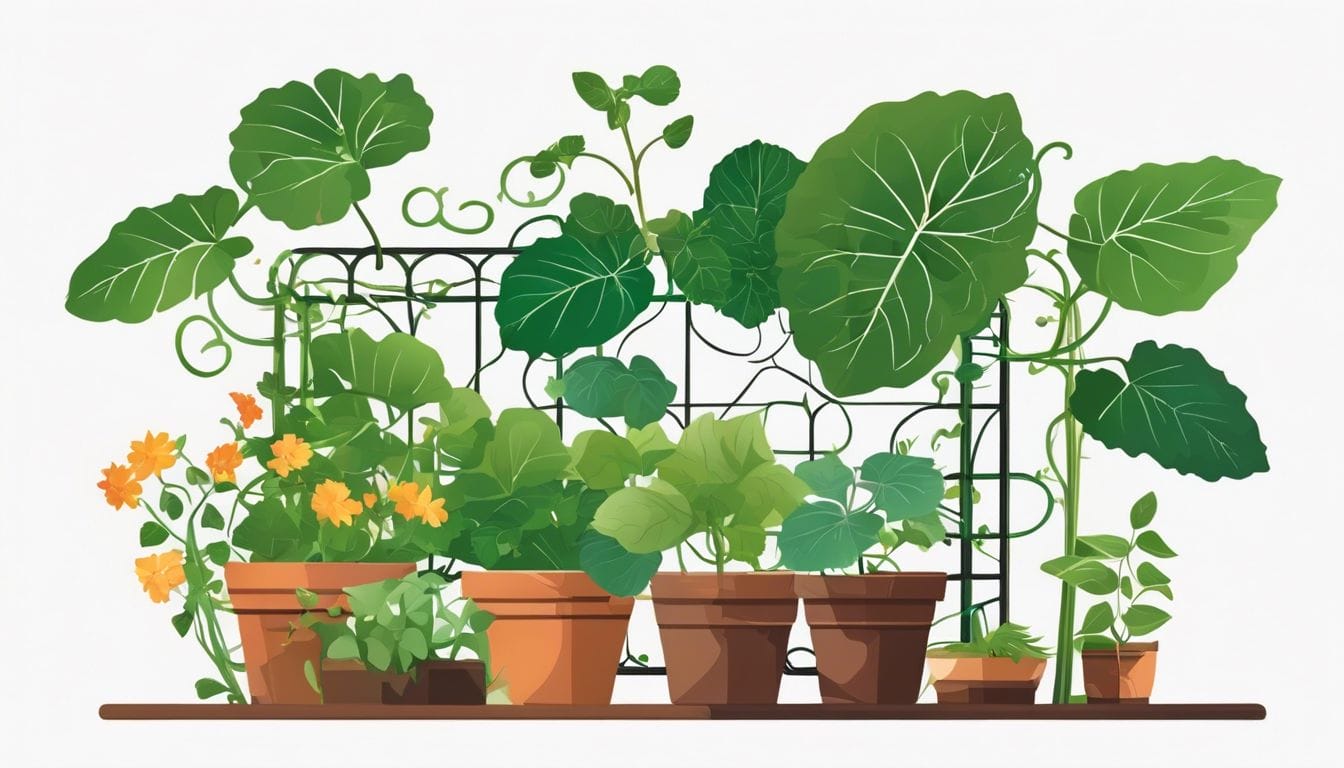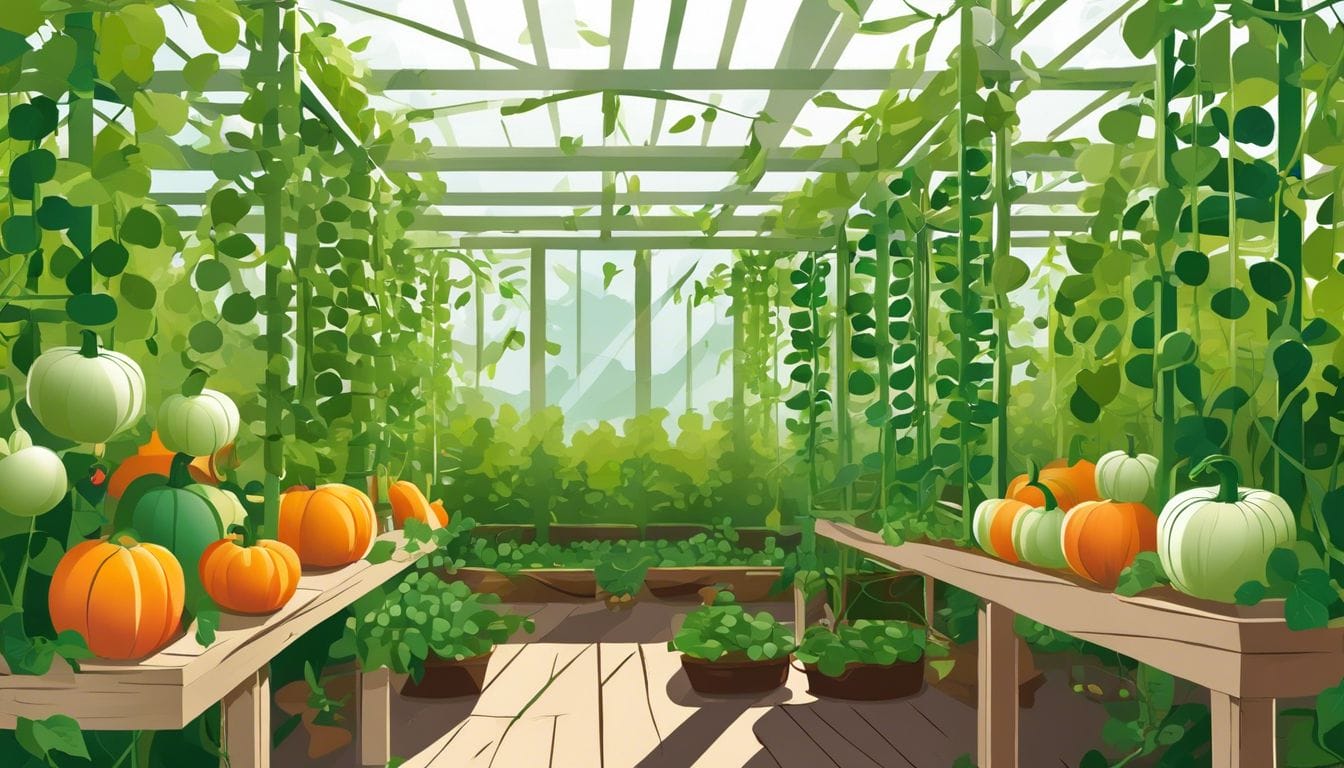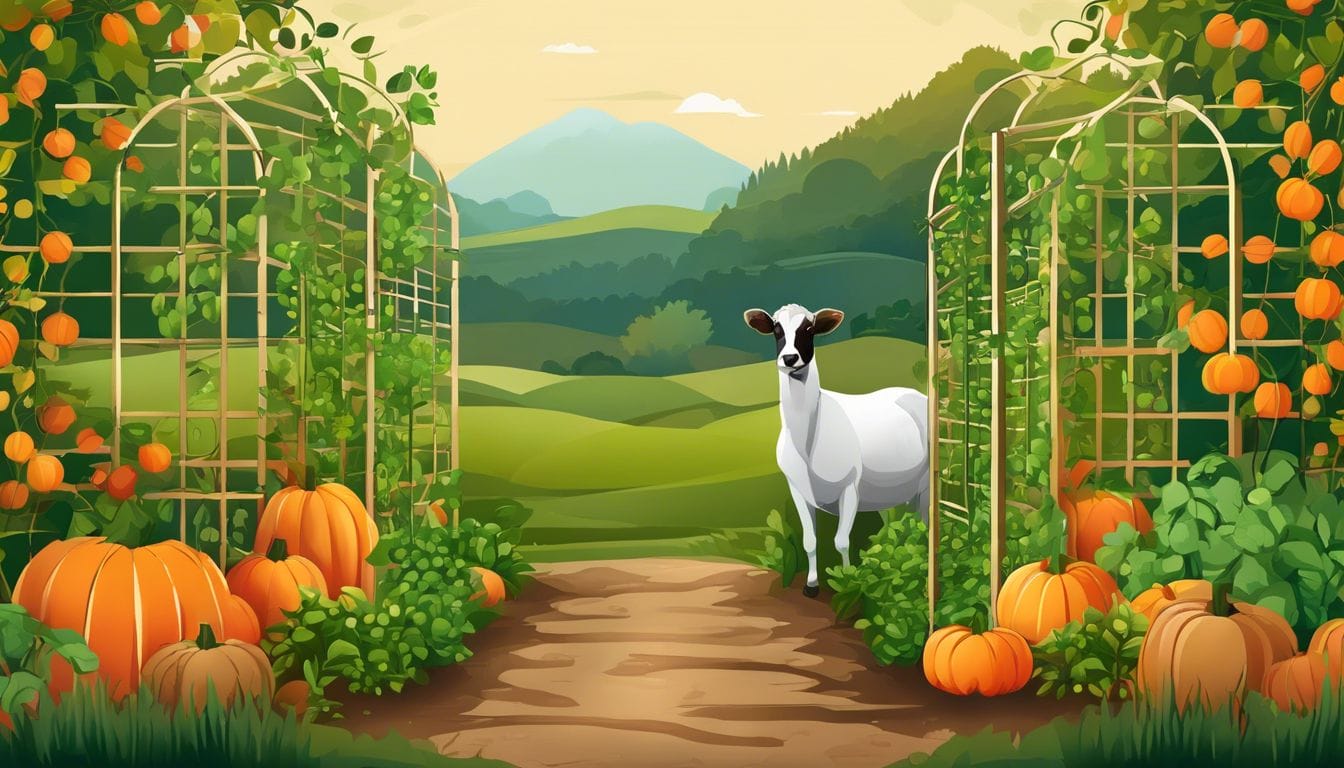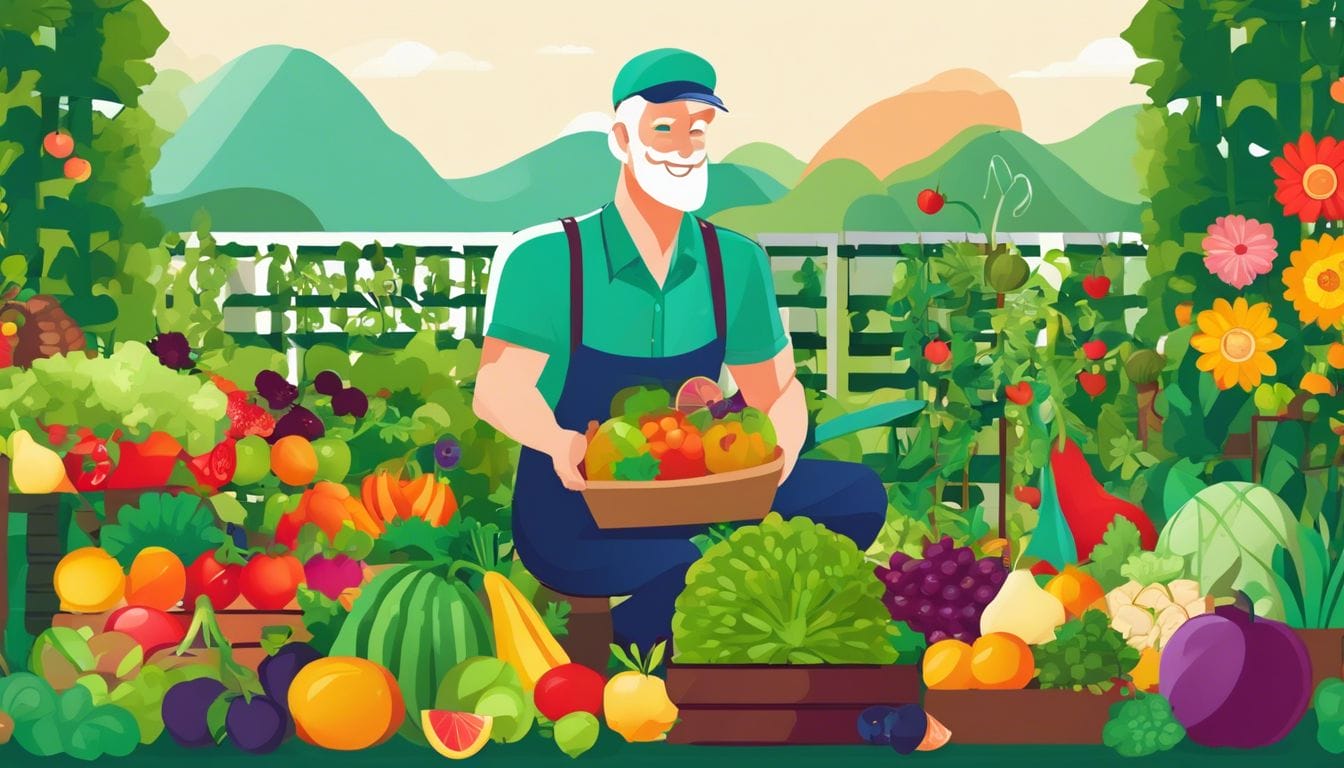Square Foot Gardening Trellises: Maximizing Plant Growth in Your Garden Bed
Even if you have limited space, it doesn’t mean you have to compromise on the bounty of your green spaces. Through the square foot gardening technique, a brilliant concept created by Mel Bartholomew, you can maximize your produce—even in the smallest of gardens—one tiny square at a time.
My journey over the past ten years has been one of nurturing green spaces wherever they may fit, showcasing that you don’t need sprawling acres for a bountiful harvest. I marry science with creativity to turn snug spots into lush, edible landscapes through smart vertical planning.
Enter the trellis—more than just garden decor—it’s your plants’ ladder to success. By letting your greens reach for the sky, they reap rewards like better air flow and sun kisses, essentials for robust growth and vibrant produce.
This isn’t just talk; it’s a proven strategy embraced by gardening aficionados everywhere who beam with pride as their vines and veggies scale these supportive structures. Ready to elevate your garden game? Join me on this climb to greener pastures!
Key Takeaways
- Square foot gardening lets you grow more by dividing your garden into small squares. You can use this space even better with trellises, which help plants like tomatoes and cucumbers climb up instead of spreading out.
- Choose the right plant types for square foot gardening with trellises. Indeterminate tomatoes and vining cucumbers work well because they keep growing upward all season long.
- When setting up trellises, make sure they’re strong and in the right place to not shade other plants. Use them to guide and support your veggies as they get taller.
- Growing on a trellis keeps plants healthier by improving air flow and making it easier to spot pests or pick veggies without stepping on other plants.
Understanding Square Foot Gardening and the Use of Trellises
As we delve into the realm of Square Foot Gardening, it’s crucial to grasp how trellises can revolutionize this method by optimizing vertical space and amplifying your garden’s productivity.
This ingenious system not only conserves ground area but also supports your climbing plants’ health and yield; think less sprawl, more upward growth! But remember, a proper setup is key: from selecting the right materials to ensuring sturdy construction—let’s get you briefed on all things trellis within your square foot sanctuary.
Introduction to Square Foot Gardening: Benefits and Basics
Square Foot Gardening is a smart way to grow lots of plants in a small space. It splits your garden bed into square foot sections, letting you pack in different veggies or flowers close together.
This method cuts down on weeding and uses less water than traditional gardens. Plus, since everything’s so close, it’s easy to reach your plants without stepping on the soil and squashing plant roots.
This gardening style was made famous by Mel Bartholomew, who wrote a book with all the details on how to set up your own grid of squares. Each square gets its own type of plant depending on how big they get.
For example, you might plant one tomato in a square but sixteen carrots can fit in another! The result? You get more food from each square foot and your garden looks neat and tidy.
Role of Trellises in a Square Foot Garden: Maximizing Vertical Space
Trellises turn a tiny patch of ground into a tower of veggies. I love using them in my square foot garden because it means I can grow more food in less space. Think about cucumbers, peas, and tomatoes reaching up instead of sprawling all over the place.
They get better air flow this way, which keeps them healthy.
I also find that with trellises, picking is a breeze – no more bending down low or stepping on other plants to reach those juicy tomatoes! And let’s not forget melons; they might be heavy but with a sling attached to the trellis, even they can defy gravity.
Plus, using something tough like cattle panels means my trellises last for seasons without fuss.
The Do’s and Don’ts of Setting Up a Square Foot Garden Trellis
I love making the most out of my garden space, and a well-built trellis can really help with that. Here are some key do’s and don’ts for setting up your square foot garden trellis:
- Do choose the right spot for your trellis. Make sure it’s on the north side of your raised bed so it doesn’t block the sun from other plants.
- Don’t forget to pick light frames and strong materials for your trellis netting or wires. They need to hold up plants without bending or breaking.
- Do plan for easy reach. Set up your trellis where you can easily grab those tasty veggies when they’re ready.
- Don’t overload your trellis with heavy feeders like pumpkins. They’re better off on the ground where they have room to spread out.
- Do use companion planting to keep pests away and make your plants happy. Plant flowers or herbs that help nearby.
- Don’t ignore plant spacing rules. Check the seed packet or use a square foot garden spacing guide to give each plant enough room to grow.
- Do think about water when setting up your trellis. Drip irrigation works great because it gets water right where it’s needed, without making leaves too wet.
- Don’t let the bottom of your plants get too crowded, which can invite pests and disease. Keep them tidy by trimming away extra growth.
- Do use zip ties or garden twine to tie plants gently to the trellis as they grow taller and need support.
- Don’t forget to check on your climbing crops often. They might need extra help as they grow bigger.
Guide to Growing Tomatoes and Cucumbers in Square Foot Gardens
Navigating the compact spaces of a square foot garden requires choosing suitable tomato and cucumber varieties that thrive when growing skyward. I’m eager to delve into techniques tailored for training these climbers on trellises, ensuring your vines reach their full potential without encroaching on neighboring plants’ territory.
With well-chosen strategies in place, your vertical bounty can be both lush and abundant, transforming even the smallest plot into a prolific vegetable oasis. Let’s explore together how to help these popular veggies flourish atop the sturdy support of carefully constructed trellises within our square foot paradise.
Choosing the Right Tomato and Cucumber Varieties for Square Foot Gardening
I’m always on the lookout for ways to make my square foot garden more fruitful. Today, I’ll share which tomato and cucumber varieties work best in this compact and efficient space.
- Look for indeterminate tomatoes, since they grow well on trellises. These types keep producing fruit all season long. Good choices are ‘Sweet Million’, ‘Sun Gold’, and ‘Cherry Cascade’. They have smaller fruits that don’t weigh down the vines.
- Try out bush varieties like ‘Bush Early Girl’ or ‘Patio Princess’ if you want a shorter plant that still gives a lot of tomatoes.
- For cucumbers, pick vining types over bush ones. Great picks include ‘Marketmore 76’, which resists disease, or ‘Straight Eight’, known for its classic taste.
- Always choose disease – resistant varieties like ‘Celebrity’ tomatoes or ‘Diva’ cucumbers to cut down on garden problems.
- When picking cucumber seeds, go for ones that say “good for trellising” or “climbing” on the packet. That way, you know they’ll reach up high with ease.
- Space-saving tip: Train your cucumber vines to climb by gently guiding them onto the trellis when they’re young. This keeps your garden tidy and your plants happy.
- Give your climbing veggies something sturdy to hold onto by setting up a heavy – duty trellis made of materials like wood or metal and using nylon netting. This helps support their weight as they grow skyward.
- Remember to plant companion plants below your tomatoes and cucumbers; flowers like marigolds can help repel pests.
Techniques for Growing Tomatoes on a Trellis in Square Foot Garden
Tomato plants love climbing up trellises in a square foot garden. This method boosts their yield and helps keep pests and diseases away.
- Choose the right tomato variety: Go for ones that climb, like indeterminate tomatoes, which grow all season long.
- Build a sturdy trellis: Use materials like wooden stakes or metal poles. The book “All New Square Foot Gardening Third Edition” is a great guide for building your own.
- Plant tomatoes properly: Place one tomato plant per square foot. Give them room to grow up, not out.
- Attach plants gently: Use soft ties or clips to connect the plants to the trellis without hurting them.
- Prune effectively: Remove extra leaves to help air flow and sunlight reach the fruits.
- Check for pests often: Catching bugs early keeps your plants healthy as they climb.
- Water wisely: Keep water at the base of the plant to avoid wet leaves, which can lead to disease.
- Support heavy branches: As tomatoes grow, they might need extra help. Tie these branches securely to the trellis.
- Add a sling for big fruit: Small to medium sized melons may need slings for support when growing vertically.
Ensuring Successful Cucumber Growth on Trellises

Growing cucumbers on trellises in my square foot garden has been a game-changer. It saves space, keeps the veggies clean, and can lead to a bigger harvest. Here’s how I make sure my cucumber plants thrive:
- Choose the right variety: I look for cucumber seeds labeled as ‘vining’ types because they love to climb.
- Build a strong trellis: I use sturdy materials like wooden posts or metal pipes that can support the weight of growing cucumbers.
- Planting setup: Cucumbers grow up, so I plant them at the base of the trellis to encourage them to reach for the sky.
- Guide them gently: As they grow, I carefully wrap the young vines around the trellis or tie them with soft ties so they know where to go.
- Watch for pests: I keep an eye out for bugs that like to eat cucumber leaves and handle them quickly if I find any.
- Water well: Cucumbers like moist soil, so I give them a good drink regularly, especially when it’s hot outside.
- Check for weight: Sometimes, when cucumbers get big, they need extra help staying on the trellis – like little slings made from old t-shirts or pantyhose.
- Harvest time: When cucumbers are just the right size, not too big or too small, it’s time to pick them so more will grow.
Mastering the Art of Trellising Peas and Pumpkins in a Square Foot Garden

Unlock the secrets to robust pea and pumpkin harvests in your square foot garden; dive into my treasure trove of best practices for trellising these bountiful climbers. Keep reading to transform the way you utilize vertical space for a flourishing, productive patch.
Best Practices for Growing Peas on Trellises in Square Foot Gardens
Growing peas on trellises in a square foot garden is a smart way to save space. It also helps keep your plants healthy and makes picking peas super easy. Here’s what you should do:
- Choose the right type of peas for trellising: Look for varieties that say “climbing”, “pole”, or “snap” on the seed packet. These peas love to grow up!
- Prepare your square foot garden bed: Make sure it’s in a spot that gets full sun because peas need lots of light.
- Set up a sturdy trellis before planting: Use materials like wood, metal, or strong netting that can hold up the pea plants as they climb and get heavier.
- Plant your pea seeds correctly: Sow them about 1 inch deep and 2 inches apart right by the base of your trellis so they can find it easily as they grow.
- Water wisely: Keep the soil moist but not soggy, especially when your pea plants start flowering and making pods.
- Help young plants get started: Gently guide them towards the trellis if they don’t cling to it by themselves.
- Support heavier pods: Sometimes, if you are growing big varieties or small melons, you might need to make little slings from fabric or pantyhose to cradle the fruit so the vines don’t break.
- Watch out for pests: Check often for signs of bugs and deal with them quickly using natural methods if you can.
- Harvest at just the right time: Pick your peas when they are plump but not too big. This will also encourage more pods to grow.
Tips and Techniques for Growing Pumpkins on a Trellis in a Square Foot Garden
I love showing off my garden full of towering plants. Growing pumpkins vertically on trellises is a true space-saver and boosts their health.
- Pick the right trellis: Choose a Livestock or Cattle Panel Trellis for its strength to hold up heavy pumpkins.
- Install it securely: Make sure your trellis is anchored well into the ground or your raised garden bed to support the pumpkin vines as they grow.
- Select suitable pumpkin varieties: Opt for smaller pumpkins that are easier to grow vertically, such as ‘Sugar Pie’ or ‘Jack Be Little’.
- Train the vines early: Gently guide young pumpkin vines onto the trellis so they know where to climb.
- Use slings for support: As small to medium-sized melons grow, support them with slings made from fabric or pantyhose attached to the trellis.
- Monitor growth closely: Keep an eye on your climbing pumpkins, repositioning slings and adjusting ties as they get bigger.
- Prune carefully: Trim excess growth to ensure air can flow around the leaves and fruits, reducing pest trouble and disease.
- Harvest with care: When it’s time, cut your pumpkins from the vine with sharp shears, holding the fruit so it doesn’t fall.
- Get creative with materials: Upcycle ladders, fences, gates, or wood pallets if you don’t have a traditional trellis.
Addressing Common Challenges of Trellising These Plants

Growing peas and pumpkins on trellises can sometimes be tough. These plants get heavy as they grow big, and they might need more help to stay up. To fix this, use strong materials like the Livestock or Cattle Panel Trellis.
This kind of trellis is tough enough to hold up bigger plants without bending or breaking.
You can also build your own trellises with things you might have around, like old ladders or wood pallets. Make sure to secure these DIY trellises well into the ground so they don’t fall over when the plants get big.
It’s smart to check the trellises often, especially when it gets windy or after a storm. If you see them leaning, push them back upright and maybe add more support if needed. With a little care, your vertical garden will let your peas and pumpkins thrive without taking up too much space!
Maintaining and Caring for Your Square Foot Garden Trellises
Keeping your square foot garden trellises in top condition doesn’t have to be a daunting task. With regular inspections and a bit of tender loving care, you can prevent many common issues that could hinder the growth of your climbing plants.
Let’s dig into some practical tips for trellis upkeep that will ensure your garden remains both beautiful and bountiful season after season.
Routine Care and Upkeep for Garden Trellises: A Practical Guide
My garden trellises are key to growing healthy climbing plants. Taking good care of them helps my garden thrive. Here’s what I do:
- Inspect your trellises regularly. Look for loose wires, rust, or wobbly parts. Fixing these early keeps your trellis strong and safe for plants.
- Clean them seasonally. Remove old plants, dirt, and leaves. This stops pests and diseases from hanging around.
- Apply a fresh coat of paint or sealant yearly if your trellis is wood. It protects it from weather damage and rot.
- Check that your trellis is still firmly in the ground. Strong winds or heavy crops can make it lean or fall.
- Tie up growing plants gently but securely. Use soft ties like cloth or special plant tape to avoid hurting the stems.
Detecting and Treating Common Trellis Issues in Square Foot Gardens
Trellises are super for growing plants up, but sometimes they have trouble. Here’s how to spot and fix common trellis problems in your square foot garden.
- Check for loose or broken parts: Look at all the spots where your trellis connects. Tighten any loose screws and replace broken parts to keep it strong.
- Watch for rust on metal trellises: If you see orange spots, that’s rust. Scrub it off with a wire brush, then paint the metal to stop more rust.
- See if wood is rotting: Poke wooden trellises with a screwdriver. Soft spots mean rot. Take away the bad wood and put in new pieces.
- Look out for wobbly trellises: If your trellis shakes, it might fall over. Push it deeper into the ground or attach supports to make it stand tall.
- Keep an eye on plant weight: Heavy plants can pull down your trellis. Use strings or cloth to help hold up big veggies like melons as they grow.
- Check if plants are too crowded: Plants need room to breathe. If they’re too close, air won’t flow well and bugs or disease might show up.
- Make sure vines grab the trellis: Sometimes plants need a little help. Tie them gently to the trellis with soft ties so they can climb up without getting hurt.
Ensuring the Longevity of Your Trellises: Expert Tips
I want my trellises to last a long time, so I use strong materials like galvanized, welded steel panels. They stand up to wind and weather without breaking down. It’s also smart to give heavy fruits some extra support when they grow up high on the trellis.
This keeps both the plants and the trellis safe.
Sometimes I find old ladders or pieces of fences that work great as trellises. Using these used items is not only good for my wallet but it’s also kinder to our planet. A book called “Trellis Tricks” taught me a lot about making sure my trellises stay in shape year after year.
And there are groups like the Square Foot Gardening Foundation that can help gardeners learn more about taking care of their garden structures too!
Can Using Trellises in Square Foot Gardening Increase the Growth Rate of Snake Plants?
Using trellises in square foot gardening can significantly enhance the snake plant growth rate. These structures provide support for the snake plants to grow vertically, allowing them to utilize space more efficiently. As the plants climb the trellises, they can receive improved access to sunlight, air circulation, and nutrients. Consequently, this increased vertical growth can lead to a faster growth rate for snake plants, resulting in healthier and more thriving vegetation.
Success Stories and Lessons Learned from Square Foot Gardening with Trellises

Explore the triumphs and valuable insights gained by gardeners who have embraced trellises in their square foot gardens. Through their experiences, we uncover the secrets to lush yields and space-efficient designs that transformed small plots into bountiful harvests.
These real-life stories not only celebrate achievements but also shed light on hiccups along the way—providing a roadmap for your own gardening adventure with these practical climbing aids.
Real-Life Insights From Successful Square Foot Gardeners
I love chatting with fellow gardeners who’ve tried square foot gardening with trellises. They always have great stories and advice to share! Here’s what I learned from them:
- Start simple: One gardener told me how she began with a single trellis and a few cucumber plants. It was easy for her to manage, and she got loads of fresh cucumbers!
- Pick the right plants: Another friend shared that green beans and peas are perfect for trellis gardening in small spaces because they climb naturally.
- Get creative with materials: A creative neighbor used old wooden ladders as trellises — not only did it look cool, but it worked great for her pole beans.
- Companion planting is key: Someone in my gardening club plants flowers at the base of his trellises. He says it helps attract helpful insects and makes his vegetable garden look amazing.
- Sturdy setups matter: A local farm stand owner warned me about cheap trellises collapsing under heavy plants. She recommends using strong materials like metal poles or thick wood.
- Keep climbing veggies trim: My aunt slices off extra leaves so her zucchini don’t get too bushy on the trellis. This lets air flow better and keeps the bugs away.
- Water wisely: My best gardening buddy uses a drip system to keep his square foot garden beds moist without wetting the leaves – less chance of disease that way.
- Watch for weight: The guy who runs the community plot advises against using trellises for super heavy veggies like pumpkins without extra support – nobody wants a pumpkin avalanche!
- Rotate crops yearly: At our last garden meeting, we learned rotating your crops helps prevent diseases from building up in the soil, even when using raised beds.
Mistakes and Lessons Learned: Tips for First-Time Square Foot Gardeners
I learned a lot from my first square foot garden. Here are some tips to help you avoid the mistakes I made:
- Not planning the garden layout ahead: It’s easy to get excited and start planting, but without a plan, your plants might not have enough space to grow. Use a plant spacing chart to ensure each plant has its spot.
- Forgetting to consider the sun: Your trellises will cast shadows as they support plants. Place them on the north side of your garden so they won’t shade smaller plants.
- Underestimating plant growth: Some plants like winter squash can get huge! Make sure your trellises are heavy duty enough to support larger plants.
- Neglecting to secure trellises well: Wind and plant weight can knock over weak trellises. Use sturdy materials and make sure they’re anchored solidly in your raised garden beds.
- Skipping routine care for trellises: Check and tighten connections throughout the growing season. This helps keep your trellises strong for supporting plants per square foot.
- Choosing the wrong types of plants: Bush beans don’t need a trellis; climbing varieties do. Pick the right type of vegetables for vertical gardening.
- Not giving melons extra support: If you grow small to medium-sized melons vertically, use slings or nets to hold up the fruit so it doesn’t fall off.
- Using poor quality materials: Cheap trellis kits may save money at first but replacing them often costs more in the long run. Invest in quality like a Livestock Panel Trellis that lasts longer.
- Planting too closely together: Even with vertical space, overcrowding can happen if you don’t follow correct plant spacing from a chart. Give each plant enough room to reach full size.
- Forgetting about different heights and harvest times: Plan where short-term crops go versus ones that stay all season. You should be able to easily reach the middle of your square foot garden without disturbing other plants.
Reviewing the Impact of Trellis Gardening: A Square Foot Gardening Perspective
Trellis gardening has truly changed the game for my square foot garden. With trellises, I get more food from each square foot because plants grow up instead of sprawling out. This means less bending and weeding for me! My tomatoes climb high, and cucumbers dangle like green ornaments from sturdy frames.
Air flows better around plants, which cuts down on disease.
Using different materials like old ladders or cattle panels makes each trellis a unique fit for my garden’s look and needs. Even heavy fruits like melons thrive with the support of slings on strong vertical structures.
And let’s not forget how much neater everything looks—my friends always admire the orderly rows of climbing peas and beans! Plus, fewer pests bother my veggies since they can’t easily reach those tender leaves way up high.
Trellis gardening in a square foot layout isn’t just smart; it’s also a joy to watch as your garden reaches new heights—literally!
Conclusion

Ask yourself, how can you grow more in less space? That’s where square foot gardening trellises come in. They let plants climb up, which means you don’t need as much room. Imagine your garden full of green vines reaching high with tomatoes and cucumbers.
Isn’t it great when everything grows well and stays healthy?.
Think about trying this way of gardening. It’s not hard to build a trellis, and it makes caring for your plants easier too. Plus, you help the planet by using less water and no chemicals.
Maybe you’ve seen gardens that look messy with plants all over the ground. With a trellis, yours won’t be like that! Your veggies will get plenty of air and be free from pests. You’ll be surprised at how much more food you can get from just a small place.
If something goes wrong or if things break, don’t worry! You can fix most problems easily, or even use stuff around your house to make new trellises.
People who have tried this say they wouldn’t go back to flat gardens again. Gardens with trellises give so much more without taking up extra space!
So why not give it a shot? Grab some wood or metal and start building today! Remember every little bit helps – for your table and our world!
FAQs
1. What is a square-foot garden trellis?
A square-foot garden trellis is a structure you can add to your planter boxes to help plants grow up instead of out, giving you more growing area in your gardening space.
2. How do I build a trellis for my square foot garden?
To build a trellis, follow the simple instructions that include using materials like electrical conduit or wood to make frames that are feet tall and wide enough to match the planting area of your bed.
3. What kind of plants work best with square foot gardening trellises?
Plants like Swiss chard, tomatoes, and beans love growing on square foot gardening trellises because they can climb and have room to flourish without taking over other plants’ space.
4. Can I use a square foot gardening method for a small garden bed?
Yes! This gardening method works great even if you only have a few square feet because it helps maximize each plant’s growth within each section of the bed by going vertical with trellises.
5. Will watering be difficult with plants grown on trellises in my garden bed?
Nope – just water as usual! Your squash plant and others on the trellis will still get all the water they need. Remember not to water too much; keep it just right for happy plants.







